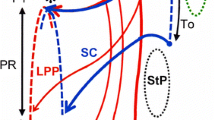Abstract
In an effort to clarify the morphologic characteristics of the palatopharyngeal muscle, we examined its origin, insertion, and positional relationship with other muscles. We found that the origin of the palatopharyngeal muscle was both the oral and the nasal side of the soft palate; it was also attached to both the palatal aponeurosis and the soft palate median. However, in some cases the muscle originated on the nasal side was lacked. When the palatopharyngeal muscle originated from both the oral and the nasal side, it traveled through its insertion via the levator muscle of the palatine velum. This insertion was seen in a wide area and could be divided into three parts: the pharynx anterior, central, and posterior walls. In the central pharyngeal wall, insertion into the pharyngeal aponeurosis, inferior constrictor pharyngeal muscle, and esophagus were observed. The present results suggest that the palatopharyngeal muscle has a close positional relationship with the levator and tensor muscles of the palatine velum, the pharyngeal constrictor muscles, and the esophagus.














Similar content being viewed by others
References
Tsumori N, Abe S, Agematsu H, Hashimoto M, Ide Y. Morphologic characteristics of the superior pharyngeal constrictor muscle in relation to the function during swallowing. Dysphagia 2007;22(2):122–129.
Shimada K, Gasser RF. Morphology of the pterygomandibular raphe in human fetuses and adults. Anat Rec 1989;224:117–122.
Bosma JF, Donner MW, Tanaka E, Robertson D. Anatomy of the pharynx, pertinent to swallowing. Dysphagia 1986;1:23–33.
Hollinshead WH. Anatomy of the pharynx and esophagus. In: English GM (ed.), Otolaryngology, Vol. 3. Philadelphia: Harper and Row, 1985, pp 1–9.
Kuehn DP, Kahane JC. Histologic study of the normal human adult soft palate. Cleft Palate Craniofac J 1990;27(1):26–35.
Kuehn DP, Moon JB. Histologic study of intravelar structures in normal human adult specimens. Cleft Palate Craniofac J 2005;42(5):481–489.
Kahrilas PJ. Pharyngeal structure and function. Dysphagia 1993;8:303–307.
Logemann JA, Pauloski BR, Rademaker AW, Colangelo LA, Kahrilas PJ, Smith CH. Temporal and biomechanical characteristics of oropharyngeal swallow in younger and older men. J Speech Lang Hear Res 2000;43:1264–1274.
Williams PL. Gray’s Anatomy, 38th ed. Philadelphia: W.B. Saunders, 1995, p 628.
McMyn JK. The anatomy of the salpingo-pharyngeus muscle. J Laryngol Otol 1940;55:1–21.
Casey DM. Palatopharyngeal anatomy and physiology. J Prosthet Dent 1983;49:371–378.
Bernard Liebgott M. The anatomical basis of dentistry. Saint Louis: Mosby-Year Book, 1986, pp 335–365.
Putz R, Pabst R. Sobotta Atlas of Human Anatomy, Vol. 1, 13th ed. Baltimore: Urban & Schwarzenberg, 2001, p 138.
Agur AMR, Dalley AF. Grant’s Atlas of Anatomy, 11th ed. New York: Lippincott, Williams & Wilkins, 2005, pp 764–766.
Abe M, Murakami G, Noguchi M, Kitamura S, Shimada K, Kohama G. Variations in the tensor veli palatini muscle with special reference to its origin and insertion. Cleft Palate Craniofac J 2004;41(5):474–484.
Shimokawa T, Yi S, Tanaka S. Nerve supply to the soft palate muscles with special reference to the distribution of the lesser palatine nerve. Cleft Palate Craniofac J 2005;42(5):495–500.
Whillis J. A note of the muscles of the palate and the superior constrictor. J Anat 1930;65:92–95.
Ohtsuka K, Tomita H, Murakami G. Anatomy of the tonsillar bed – topographical relationship between the palatine tonsil and the lingual branch of the glossopharyngeal nerve. Acta Otolaryngol Suppl 2002;546:99–109.
Cassell MD, Moon JB, Elkadi H. Anatomy and physiology of the velopharynx. In: Bardach J, Morris HL (eds.), Multidisciplinary Management of Cleft Lip, Palate. Philadelphia: W. B. Saunders, 1990, pp 366–377.
Acknowledgments
These studies were supported by Grants-in-Aid for Scientific Research (No. 19592131, S. Abe) from the Ministry of Education, Culture, Sports, Science and Technology (MEXT) of Japan, by the Foundation of Japan Medical Association, by Oral Health Science Center Grant HRC7 (S. Abe) from Tokyo Dental College, and by a “High-Tech Research Center” Project for Private Universities matching fund subsidy from MEXT, 2006-2011.
Author information
Authors and Affiliations
Corresponding author
Rights and permissions
About this article
Cite this article
Okuda, S., Abe, S., Kim, HJ. et al. Morphologic Characteristics of Palatopharyngeal Muscle. Dysphagia 23, 258–266 (2008). https://doi.org/10.1007/s00455-007-9133-0
Received:
Accepted:
Published:
Issue Date:
DOI: https://doi.org/10.1007/s00455-007-9133-0




